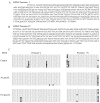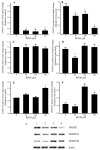Brain-Derived Neurotrophic Factor Mediated Perfluorooctane Sulfonate Induced-Neurotoxicity via Epigenetics Regulation in SK-N-SH Cells
- PMID: 28441774
- PMCID: PMC5412472
- DOI: 10.3390/ijms18040893
Brain-Derived Neurotrophic Factor Mediated Perfluorooctane Sulfonate Induced-Neurotoxicity via Epigenetics Regulation in SK-N-SH Cells
Abstract
Perfluorooctane sulfonate (PFOS), a new kind of persistent organic pollutant, is widely distributed in the environment and exists in various organisms, where it is also a neurotoxic compound. However, the potential mechanism of its neurotoxicity is still unclear. To examine the role of epigenetics in the neurotoxicity induced by PFOS, SK-N-SH cells were treated with different concentrations of PFOS or control medium (0.1% DMSO) for 48 h. The mRNA levels of DNA methyltransferases (DNMTs) and Brain-derived neurotrophic factor (BDNF), microRNA-16, microRNA-22, and microRNA-30a-5p were detected by Quantitative PCR (QPCR). Enzyme Linked Immunosorbent Assay (ELISA) was used to measure the protein levels of BDNF, and a western blot was applied to analyze the protein levels of DNMTs. Bisulfite sequencing PCR (BSP) was used to detect the methylation status of the BDNF promoter I and IV. Results of MTT assays indicated that treatment with PFOS could lead to a significant decrease of cell viability, and the treated cells became shrunk. In addition, PFOS exposure decreased the expression of BDNF at mRNA and protein levels, increased the expression of microRNA-16, microRNA-22, microRNA-30a-5p, and decreased the expression of DNMT1 at mRNA and protein levels, but increased the expression of DNMT3b at mRNA and protein levels. Our results also demonstrate that PFOS exposure changes the methylation status of BDNF promoter I and IV. The findings of the present study suggest that methylation regulation of BDNF gene promoter and increases of BDNF-related-microRNA might underlie the mechanisms of PFOS-induced neurotoxicity.
Keywords: BDNF; DNA methylation; DNMTs; PFOS; microRNA.
Figures






Similar articles
-
PFOS Disturbs BDNF-ERK-CREB Signalling in Association with Increased MicroRNA-22 in SH-SY5Y Cells.Biomed Res Int. 2015;2015:302653. doi: 10.1155/2015/302653. Epub 2015 Nov 15. Biomed Res Int. 2015. PMID: 26649298 Free PMC article.
-
MicroRNA expression changes during zebrafish development induced by perfluorooctane sulfonate.J Appl Toxicol. 2011 Apr;31(3):210-22. doi: 10.1002/jat.1583. Epub 2010 Sep 28. J Appl Toxicol. 2011. PMID: 20878907
-
Effects of subchronic perfluorooctane sulfonate exposure of rats on calcium-dependent signaling molecules in the brain tissue.Arch Toxicol. 2010 Jun;84(6):471-9. doi: 10.1007/s00204-010-0517-9. Epub 2010 Feb 2. Arch Toxicol. 2010. PMID: 20127074
-
Role of BDNF epigenetics in activity-dependent neuronal plasticity.Neuropharmacology. 2014 Jan;76 Pt C:709-18. doi: 10.1016/j.neuropharm.2013.04.002. Epub 2013 Apr 12. Neuropharmacology. 2014. PMID: 23587647 Review.
-
Environmental contamination, human exposure and body loadings of perfluorooctane sulfonate (PFOS), focusing on Asian countries.Chemosphere. 2012 Oct;89(4):355-68. doi: 10.1016/j.chemosphere.2012.05.043. Epub 2012 Jul 12. Chemosphere. 2012. PMID: 22794940 Review.
Cited by
-
The Threat Posed by Environmental Contaminants on Neurodevelopment: What Can We Learn from Neural Stem Cells?Int J Mol Sci. 2023 Feb 22;24(5):4338. doi: 10.3390/ijms24054338. Int J Mol Sci. 2023. PMID: 36901772 Free PMC article. Review.
-
Toward a Mechanistic Understanding of Poly- and Perfluoroalkylated Substances and Cancer.Cancers (Basel). 2022 Jun 14;14(12):2919. doi: 10.3390/cancers14122919. Cancers (Basel). 2022. PMID: 35740585 Free PMC article. Review.
-
The BDNF-TrkB-CREB Signalling Pathway Is Involved in Bisphenol S-Induced Neurotoxicity in Male Mice by Regulating Methylation.Toxics. 2022 Jul 23;10(8):413. doi: 10.3390/toxics10080413. Toxics. 2022. PMID: 35893846 Free PMC article.
-
ROS-Triggered Autophagy Is Involved in PFOS-Induced Apoptosis of Human Embryo Liver L-02 Cells.Biomed Res Int. 2021 Apr 5;2021:6625952. doi: 10.1155/2021/6625952. eCollection 2021. Biomed Res Int. 2021. PMID: 33880372 Free PMC article.
-
Exposure to Perfluoroalkyl Substances During Pregnancy and Fetal BDNF Level: A Prospective Cohort Study.Front Endocrinol (Lausanne). 2021 Jun 1;12:653095. doi: 10.3389/fendo.2021.653095. eCollection 2021. Front Endocrinol (Lausanne). 2021. PMID: 34140927 Free PMC article.
References
-
- Bhavsar S.P., Fowler C., Day S., Petro S., Gandhi N., Gewurtz S.B., Hao C., Zhao X., Drouillard K.G., Morse D. High levels, partitioning and fish consumption based water guidelines of perfluoroalkyl acids downstream of a former firefighting training facility in canada. Environ. Int. 2016;94:415–423. doi: 10.1016/j.envint.2016.05.023. - DOI - PubMed
MeSH terms
Substances
LinkOut - more resources
Full Text Sources
Other Literature Sources

